How To Install Basement Stair Railing
 Stair Rails & Stair Baby-sit Codes
Stair Rails & Stair Baby-sit Codes
- POST a QUESTION or Comment on building, installing & inspecting stair rails and stair baby-sit rails - safety & regulations
InspectAPedia tolerates no conflicts of interest. Nosotros have no relationship with advertisers, products, or services discussed at this website.
Stair rails or stair guards:
This article explains and illustrates the requirements for a stair baby-sit forth the open up side of steps and stairways. We explain the difference between a stair rails and a handrail and their different requirements, and we describe using the top member of a stair rail as a handrailing.
This article series provides edifice code specifications, sketches, photographs, and examples of stair & railing safety defects used in inspecting indoor or outdoor stair railings or handrails and related weather for safety and proper construction.
We also provide an ARTICLE INDEX for this topic, or you can try the page top or bottom SEARCH BOX every bit a quick manner to notice information you demand.
Stair Rail / Stair Guardrail Specifications & Defects: requirements for stair guards or guard railings along steps, stairs & stairways
 Definition of stairrail or stair track systems - guards along stairways
Definition of stairrail or stair track systems - guards along stairways
At the stairs shown at left, we are missing both handrailings and stair rails.
Article Contents
- STAIR Rails, STAIR GUARDS
- When are Stair Railings Required?
- How many steps, what total rising summit requires a stair track or guard?
- When is a stair rail also an acceptable handrail?
- Stair Guardrail Specifications from CA/OSHA Title eight Department 1626
- Unsafe or Non-Functional Stair Railings Contribute to Stair Falls & Injuries
- Photo Guide to unsafe stair rail or stair guards & unsafe stair rail tops used as handrailings
- A Comparison of Building Codes Specifying Stair Rail (guard) Requirements
- What are the differences between guardrail heights and stair rail heights, & what are acceptable methods for raising the height pinnacle of a stair track that is too brusque?
A stair rails is a guard along the open up side or sides of a stairway. [The stair rail or stair guard top runway is shown past the scarlet arrows in our photo at the top of this folio.]
Call up guardrail for an open stair. In most specifications such as you'll meet beneath, the height requirements for stair rails and handrails are identical. They differ but in graspability.
Watch out: If y'all build stairs with a non-graspable stair rail (guardrail along open stairs) you must provide a graspable handrailing and the dimensions, spacing, superlative, projection, etc. for handrails must however be maintained.
Railings in stair codes and specifications refer to the safety barrier along steps or stairs. Also see GUARDRAILS on BALCONIES, DECKS, LANDINGS for details nearly safety railings on landings and open hallways, porches, screened porches, balconies - horizontal walking surfaces.
Railing Types - A Quick Guide
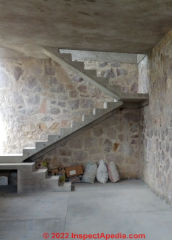 Photograph: of stairs missing the stair guards: this iii-flight stairway with ii intermediate landings was seen in a abode in Guanajuato, Mexico.
Photograph: of stairs missing the stair guards: this iii-flight stairway with ii intermediate landings was seen in a abode in Guanajuato, Mexico.
At least the upper landing is short, providing less than 36" in the direction of travel, but information technology is the complete absence of baby-sit railings along this stair that are perhaps the more than-serious hazard.
- A guardrail is a safety railing or barrier located along a horizontal surface such equally a balustrade, deck, or porch. Details are
at GUARDRAILS on BALCONIES, DECKS, LANDINGS - this commodity. A guardrail is shown by the scarlet arrows in our photo at left.
- A stair rail or stair baby-sit is a safe railing or bulwark located forth the open up side(due south) of a stairway. Details are
at STAIR RAILS, STAIR GUARDS - this article.
- A handrailing or stair railing is installed along one or both sides of an ascending / descending stairway, to provide a rubber grasping surface to reduce fall injuries, and where stairways are open, to forestall falls off of the side of the stairs. Details are
at HANDRAILS & HANDRAILINGS
The 2006 IRC Section R202 these terms are divers clearly. We add some comments.
When are Stair Runway Required? How many steps, what total rise summit requires a Stair Rail or Guard?

The last authority on when and where railings are required on steps, stairs, landings, balconies and decks, rests with your local building code official. The building code requirement for stair railings typically requires stair rails or stair guards (and also handrailings) on stairs that accept a total rising of three anxiety or more.
Our photograph above illustrates a stair that has no functional stair guard - none is installed along the open side of the stairs. The handrailing that is provided is un fortunately non usable: my left hand is on a manus railing too low to grasp when descending the stairs
OSHA Stair rails requirements & notation that stair rail may serve as handrails, and vice-versa
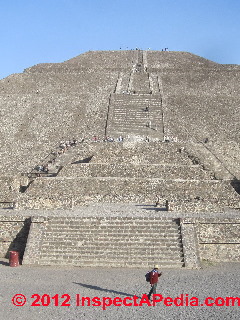
Our photo (above left) illustrates very challenging stairs with a loftier rise, climbing to over 230 feet at the Pyramid of the Sun in Teotihuacán outside of United mexican states City.
Adding to the challenge is the combination of uneven and very tall rise steps, the starting altitude (7350 feet) that can add to dizziness for tourists, a flexible cablevision "handrailing", and the sunday itself. Construction began abut 2 A.D., a bit before OSHA was established.
OSHA, in describing stairs built for apply during building structure, specifies these details: [6]
The following general OSHA requirements apply to all stairways and stair rail:
- Stairways with iv or more risers or ascent more than thirty inches (76 cm) in peak- whichever is less- must exist installed along each unprotected side or edge. When the peak edge of a stair track arrangement as well serves as a handrail, the acme of the tiptop border must be no more than than 37 inches (94 cm) nor less than 36 inches (91.5 cm) from the upper surface of the stair rail to the surface of the tread.
- Stair runway installed afterwards March 15,1991, must exist not less than 36 inches (91.5 cm) in height.
- Elevation edges of stair rail systems used equally handrails must not be more than 37 inches (94 cm) high nor less than 36 inches (91.5 cm) from the upper surface of the stair rail system to the surface of the tread. (If installed before March 15, 1991, non less than 30 inches [76 cm]).
- Stair rail systems and handrails must be surfaced to preclude injuries such as punctures or lacerations and to keep clothing from snagging.
- Ends of stair runway systems and handrails must be built to prevent unsafe projections, such every bit rails protruding beyond the cease posts of the system.
- Unprotected sides and edges of stairway landings must accept standard 42-inch (1.1 m) guardrail systems.
- Intermediate vertical members, such as balusters used as guardrails, must not be more than 19 inches (48 cm) apart.
- Other intermediate structural members, when used, must be installed and so that no openings are more than than 19 inches (48 cm) wide.
- Screens or mesh, when used, must extend from the elevation rails to the stairway step and forth the opening between top rail supports.
When is a stair rail also an adequate handrail?
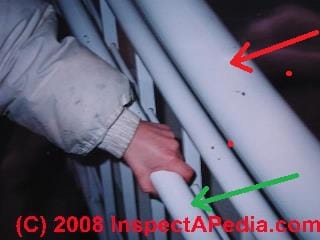 Some codes (CA/OSHA Championship 8 Section 1626) may crusade a little confusion between the definition of handrail (greenish arrow) and guardrail, past adding a third term, stair rail (reddish pointer).
Some codes (CA/OSHA Championship 8 Section 1626) may crusade a little confusion between the definition of handrail (greenish arrow) and guardrail, past adding a third term, stair rail (reddish pointer).
A stair runway is basically a guard track along an open up stairway. A stair rail may itself be graspable and serve equally a handrailing, or the stair rail might exist higher, larger, and not-graspable, equally shown in our photo at left. [When these stairs were first constructed, the handrail was non present.]
The following requirements apply to all stairways as indicated:
1926.1052(c)(ane) Stairways having four or more risers or rising more than xxx inches (76 cm), whichever is less, shall be equipped with:
(A) At least 1 handrail; and
(B) A stair rail consisting of a top rails and mid-rail along each unprotected side or border.
This separation of handrail from stair runway appears intended to allow the construction of the equivalent of a "guardrailing" forth open stairways and consisting of non just the horizontal members described in (B) above.
But along an open stairway there will besides be a requirement for vertical balusters or other means of enclosing the open or unprotected side or border. Here "unprotected" side or border means an "open" stairway - that is, stairs that do not run along an enclosing building wall.
Stair Rail - Stair Guardrail Specifications from CA/OSHA Title eight Section 1626

Continuing from CA/OSHA Title viii Department 1626 [paragraph (1) is given and discussed above]:
1926.1052(c)(2) Winding and spiral stairways shall exist equipped with a handrail offset sufficiently to prevent walking on those portions of the stairways where the tread width is less than half-dozen inches (xv cm).
1926.1052(c)(iii) The height of stair rails shall be not less than 34 inches nor more than 38 inches from the upper surface of the stair rail to the surface of the tread, in line with the face of the riser at the forward border of the tread.
1926.1052(c)(four) Mid-runway shall be located at a superlative midway between the top edge of the stair rail and the stairway steps.
(A) Screens, mesh, or other textile, when used in lieu of mid-rails, shall extend from the superlative rails to the stairway step, and along the entire opening between tiptop rail supports.
(B) Other structural members, when used, shall be installed such that there are no openings in the stair runway that are more than 18 inches (46 cm) wide.
1926.1052(c)(5) Handrails and the top runway of stair rails shall exist capable of withstanding, without failure, a force of at least 200 pounds (890 n) applied within 2 inches (5 cm) of the elevation edge, in whatever downward or outward direction, at any indicate along the elevation edge.
1926.1052(c)(half dozen) The height of handrails shall be not less than 34 inches nor more than 38 inches from the upper surface of the handrail to the surface of the tread, in line with the confront of the riser at the forrad edge of the tread.
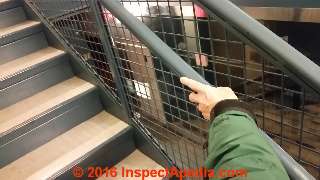
1926.1052(c)(7) When the meridian edge of a stair rail besides serves as a handrail, the top of the superlative edge shall exist non less than 34 inches nor more than 38 inches from the upper surface of the stair track to the surface of the tread, in line with the face of the riser at the forward border of the tread.
1926.1052(c)(viii) Stair track and handrails shall exist then surfaced as to prevent injury to employees from punctures or lacerations, and to foreclose snagging of clothing.
1926.1052(c)(nine) Handrails shall provide an adequate handhold. [This means that handrails must be graspable.]
1926.1052(c)(10) The ends of stair rails, handrails and mid-runway shall be synthetic so every bit not to establish a projection take chances.
1926.1052(c)(11) Handrails that will not exist a permanent part of the construction beingness built shall take a minimum clearance of 3 inches (8 cm] between the handrail and walls, stairrail systems, and other objects.
Snag Hazards in Stair Railings or Stair Guards tin contribute to falls
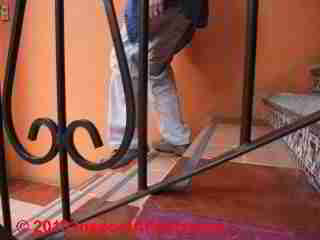
A 2022 survey of model residential building codes and edifice codes for several U.Southward. states (CA, CT, NY, PA) left us looking for proficient citations alarm about snag hazards caused specifically past snag hazards forth stair railings or stair guards.
Rules for residential stairway handrailing are clear about handrail continuity, projections, polish graspable surfaces, and returns. But model and state building codes that we surveyed did not explicitly address snag hazards built into the guardrail itself.
Nosotros did find some general references to stair rails (railings or guardrails, as distinct from handrails) that imply continuity and smoothness, and in OSHA regulations nosotros can detect rfeferences to avoiding snags forth stair guards.
Please run into SNAG HAZARDS on STAIRWAYS for details near this topic.
Unsafe or Non-Functional Stair Railings Contribute to Stair Falls & Injuries
Don't Underestimate the Importance of Stair Railings or Guards
Stance: Daniel Friedman. The following opinions derive the author's feel in building stairs, inspecting stairs in and at buildings, in researching stair construction practices & building codes, and in the occasional aid in the investigation of stair falls.
Examples of Stair Rail or Stair Guardrail Safety Hazards
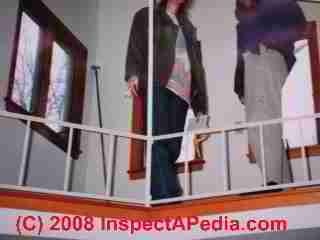
- Railing wrong top on stairs (above) or landing (at left) - also depression to grasp or too high to grasp, or too depression to prevent falling off of a platform, as I'm demonstrating in the correct-paw photo to a higher place and in the stair landing photo shown here.
- Railing loose, not properly secured (litigation photos)
- Railing missing
- Railing wrong dimension - cannot grasp; railing does not permit continuous grasping over length
While it is readily apparent that a loose, cleaved, or defective guardrail on a deck, balcony, or landing can contribute to or even cause a bad fall, nosotros sometimes find that the part of the stairrail in stair fall injuries is underestimated or missed entirely by people investigating such accidents.
The proper construction and physical status of the stair rail at whatever stairway should be an important part of the investigation conducted to empathise the cause & extent of stair falls and fall-related injuries.
Reader Question: Is it "legal" for a basement stair to have no stair runway, stair guards, or handrailing?
 I am purchasing a condo and there is no handrail on the stairs leading to the basement. in that location is a wall on the left and no handrail on the right. is this legal in new york state, and or nassau county? give thanks y'all for you assistance, S.F. 7/26/12
I am purchasing a condo and there is no handrail on the stairs leading to the basement. in that location is a wall on the left and no handrail on the right. is this legal in new york state, and or nassau county? give thanks y'all for you assistance, S.F. 7/26/12
Reply:
Our photo (at left) shows a mutual but unsafe lower flooring or basement stair condition in an older home.
To make it possible to move large furniture or other objects between floors someone has removed the handrail and balusters that were originally installed on the open side of this stairway. We are sure that a stair track was originally in place because we see the bottom newel post in our photo.
This is an unsafe stairway - information technology has no stair guard or stair rail along the open side of the stairway and information technology has and no handrailings on either side.
The rail and balusters that were removed and that previously formed both a stair runway and a handrailing should be replaced. If the stair is more three feet wide (probably it's not), and for all stairs in some jurisdictions, a handrail may as well be required forth the enclosed wall side of the stairs as well . The "legality" of this or any other building condition is in the final hands of the local building lawmaking department and officials.
Spotter out: sometimes a local building department or official volition result a certificate of occupancy or "CO" on a building with conditions like the one shown here, either because the site was not really visited (instead the "CO" indicates that there were "no issues on file") or because the official just didn't notice or didn't recognize an improper or unsafe condition. Nevertheless, a "CO" does not prevent accidents nor litigation.
"Proverb information technology's OK" doesn't brand it "OK" if an dangerous condition exists, and if there is an injury the building department is not going to pay the injured person'due south medical bills.
More Photographs of Unacceptable / Unsafe Stair Rails or Stair Rail Tops Used as Handrailings
Explanation of non-graspable stair railings
The photographs below illustrate a non-graspable handrailing located along the stair runway or stair guard of an open stairway. While thumb and finger grooves were provided, the width of the stair rails top, intended to serve every bit a handrailing, is also great to be safely grasped.


Our stair handrail photo (left) illustrates an attractive stainless-steel runway on a lower stairway in the New York City Metropolitan Opera edifice. As you can see from our model's manus on pinnacle of the railing, the width of this particular rail, roughly 6", is too slap-up to be grasped and held on-to should a stair fall occur. A 2x6" shape on edge, is also not readily graspable.

As we cited in OSHA'southward guidelines above, and equally you will read in every expert source on proper stairway rail summit used as a handrail or "banister" blueprint in our references at the finish of this article, to be usable and functional, a handrailing must be of a size and shape than tin be easily grasped, must exist at the proper acme to a higher place the steps (measured at the tread front end nose), must exist separated from the side wall (if nowadays) at an adequate altitude to permit the hand to grasp the railing, and must be continuous.
And of course the railing must also be secured soundly to the structure. If any of these features are violated the hand railing is unsafe.
An unsafe handrailing may go unnoticed for a long fourth dimension, even years. Simply an improperly designed or installed handrail is likely to be discovered, and volition contribute to the extent of injuries suffered by someone who slips, trips, or falls when using the stairs.
Also Wide or Too Fat Handrails Cannot be Grasped When Falling

One of my [DF] daughters fell downwardly these curved stairs at the Galleria shopping mall (DC-NY) where the triangular tread take a chance was combined with a cute, architect-designed stair rail that was nigh 8" in diameter (photograph at left, red arrow) - she was unable to grasp it as she was falling.
The photograph shows her older sister grasping an added handrail (green arrow) that appears to have been added on to correct this unsafe status.
The original "fat" manus railing that no 1 could grasp when falling remains installed but we practice not recommend relying on information technology.


Higher up we evidence photographs of two more not-graspable handrails that are dangerous: at left at Carnegie Hall in New York City, and at correct demonstrated by Asta in San Miguel de Allende, Mexico. The "stair rails" at correct is not only too big, it'southward as well too depression.
A Comparing of Building Codes Specifying Stair Runway (guard) Requirements
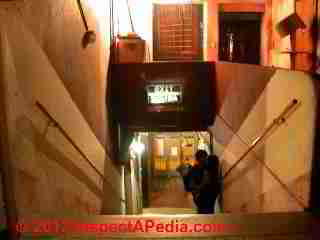 Sample excerpts of sources which a edifice lawmaking compliance inspector would be expected to cite in support of requiring a properly-designed, properly-secured guard rails include simply are not limited to the citations below.
Sample excerpts of sources which a edifice lawmaking compliance inspector would be expected to cite in support of requiring a properly-designed, properly-secured guard rails include simply are not limited to the citations below.
Our photograph (left) indicates mid-stairway activities that could require secure handrailings at a Tango dance hall in Buenos Aires.
International Edifice Lawmaking 2000 (BOCA, ICBO, SBCCI) Handrail Rules
1003.three.3.11.three Handrail grasp ability. Handrails with a circular cross department shall have an outside diameter of at least 1.25 inches (32 mm) and non greater than two inches (51 mm) or shall provide equivalent grasp ability. If the handrail is not circular, it shall have a perimeter dimension of at least 4 inches (102 mm) and not greater than half dozen.25 inches (159 mm) with a maximum cross-department dimension of 2.25 inches (57 mm). Edges shall accept a minimum radius of 0.125 inch (3.2 mm).
100333.11.four Continuity. Handrail-gripping surfaces shall be continuous, without interruption by newel posts or other obstructions.
1607.7 Loads on Handrails, guards, grab bars and vehicle barriers
1607.seven.1.1 Concentrated Load. Handrail assemblies and guards shall exist able to resist a single concentrated load of 200 pounds (0.89kN), applied in any direction at any point along the pinnacle, and take attachment devices and supporting structure to transfer this loading to advisable structural elements of the building.
1607.seven.i.ii Components. Intermediate rails (all those except the handrail), balusters and panel fillers shall be designed to withstand a horizontally applied normal load of 50 pounds (0.22 kN) on an area not to exceed ane square foot (305mm2) including openings and space between rail.
BOCA National Property Maintenance Code 1993 Handrailing Requirements
PM-305.5 Stairs and railings: all interior stairs and railings shall be maintained in sound condition and good repair.
Commentary: Handrails, treads and risers must exist structurally sound, firmly fastened to the structure, and properly maintained to perform their intended office safely. During an inspection the code official should inspect all stringers, risers, treads, and handrails.
PM-305.half dozen Handrails and guards: Every handrail and guard shall be firmly fastened and capable of supporting normally imposed loads and shall exist maintained in good status.
Commentary: This section provides for the safety and maintenance of handrails and guards. Encounter Department PM-702.9 for additional requirements.
PM-702.9 Stairways, handrails and guards: Every exterior and interior flight of stairs having more than four risers, and every open portion of a stair, landing or balcony which is more than 30 inches (762mm) high, nor more than 42 inches (1067mm) high, measured vertically above the nosing of the tread or above the finished floor of the landing or walking surfaces. Guards shall exist not less than xxx inches (762mm) high to a higher place the floor of the landing or balcony.
Commentary: Handrails are required on all stairs more than four risers in height. Handrails cannot be less than 30 inches nor more than 42 inches above the nosing of the treads (see Effigy PM-702.9).
Guards are required on the open side of stairs and on landings and balconies which are more than thirty inches above the flooring or course below. The guard must be at least 30 inches above the floor of the landing or balcony.
Guards are to contain intermediate track, balusters or other construction to reduce the risk of an adult or kid from falling through the guard. If the guard is missing some intermediate runway or balustrades, information technology is recommended that the baby-sit be repaired to its original condition if information technology will provide protection equivalent to the protection information technology provided when originally constructed.
Uniform Building Lawmaking Stairway, Railing, & Guardrail Specifications (UBC 10.3.3.36)
Using 1997 UBC version every bit a model [38]
Stairway Handrail Widths:
The handgrip portion of handrails shall not be less than 1-i/4 inches (32 mm) nor more than 2 inches (51 mm) in cross-sectional dimension or the shape shall provide an equivalent gripping surface. The handgrip portion of handrails shall take a smooth surface with no sharp corners. Handrails projecting from a wall shall accept a space of not less than i-1/two" (38 mm) betwixt the wall and the handrail.
Stairway Handrail Heights:
The top of handrails and handrail extensions shall not be placed less than 34" (864 mm) nor more than 38 inches (965 mm) in a higher place landings and the nosing of treads. Handrails shall be continuous the full length of the stairs and at least one handrail shall extend in the direction of the stair run not less than 12 inches (305 mm) beyond the top riser nor less than 12 inches (305mm) beyond the bottom riser. Ends shall be returned or shall have rounded terminations or bends.Exceptions:
one. Individual stairways practice not require handrail extensions
2. Handrails my take starting or volute newels within the starting time tread on stairways in Grouping R, Partitioning iii Occupancies and within individual dwelling units of Group R, Partition 1 Occupancies.
Stair Handrail requirements: "on each side"
Stairways shall accept handrails on each side, and every stairway required to exist more than than 88 inches (2235 mm) in width shall be provided with not less than ane intermediate handrail for each 88 inches (2235 mm) or required width.
Intermediate handrails shall be spaced approximately as beyond with the entire width of the stairway.Exceptions:
ane. Stairways less than 44 inches (1118 mm) in width or stairways serving one individual dwelling unit in Group R, Partition i or 3 Occupancy or a Group R, Division 3 congregate residence may have one handrail.
two. Individual stairways 30 inches (762) or less in tiptop may have a handrail on one side only.
3. Stairways having less than four risers and serving one individual habitation unit in Group R, Partition 1 or 3, or a Group iv, Partitioning three besiege residence or Group U Occupancies demand not have handrails.
California Building Code Handrailing Specifications (CBC 1003.3.3.6)
The intent of a handrail is to provide a handgrip for people using a stairway. Stairways which serve an individual dwelling unit of measurement must have a handrail on 1 side if they have four risers or more.
Such stairways with fewer than four risers are not required to have handrails. Handrails projecting from a wall shall have not less than 1 1/2 inches between the wall and handrail.
Handrails must be placed betwixt thirty-four and 30-8 inches above the nosing of the stair treads.
Ends [of the stair handrailings] must be returned or have rounded terminations or bends. The handgrip portion of handrails shall non be less than 1 ane/4 inches nor more than two inches in cross-sectional dimension or the shape shall provide an equivalent gripping surface.
The handgrip portion of handrails shall have a smoothen surface with no precipitous corners. [37]
California CA/OSHA Championship eight Building Code Stair & Railing Safety & Structure Details
Note: this lawmaking establishes minimum occupational safety & wellness standards that apply to all places of employment in California. This is non a residential edifice code requirement, but this text in our Stance models stair construction safety & design specifications.
Also see STAIR TREAD DIMENSIONS and the other stair measurement parameter subtopics outlined in our detailed article links listed at the Article Index the bottom of this commodity .
CA OSHA Title eight Section §3214. Stair Rails and Handrails [35]
(a) Stairways shall have handrails or stair railings on each side, and every stairway required to be more than than 88 inches in width shall be provided with not less than 1 intermediate stair railing for each 88 inches of required width. Intermediate stair railings shall exist spaced approximately equal within the unabridged width of the stairway.
Notation: Intermediate stair railings may be of single rail construction.
Exceptions:
(1) Stairways less than 44 inches in width may have one handrail or stair railing except that such stairways open on one or both sides shall take stair railings provided on the open side or sides.
(2) Stairways having less than four risers need not accept handrails or stair railings.
(3) Stairways giving access to portable work stands less than 30 inches high.
(4) Stairs that follow the contour of tanks or other cylindrical or spherical structures where the construction requires the inside clearance between the inside stair stringer and wall or tank side to be viii inches or less, shall non be considered an "open side."
(5) Guardrails may exist erected provided a handrail is attached.
(b) A stair railing shall be of construction similar to a guardrail (encounter Section 3209) but the vertical summit shall be in compliance with Section 3214(c). Stair railings on open sides that are 30 inches or more higher up the surface below shall exist equipped with midrails approximately one half way between the steps and the top rail.
Note: Local edifice standards may require 4-inch spacing of intermediate vertical members.
(c) The top of stair railings, handrails and handrail extensions installed on or after Apr 3, 1997, shall be at a vertical meridian betwixt 34 and 38 inches above the nosing of treads and landings.
For stairs installed before Apr 3, 1997, this height shall be betwixt 30 and 38 inches.
Stair railings and handrails shall be continuous the total length of the stairs and, except for private stairways, at least one handrail or stair railing shall extend in the direction of the stair run non less than 12 inches beyond the acme riser nor less than 12 inches beyond the bottom riser.
Ends shall be returned or shall stop in newel posts or prophylactic terminals, or otherwise arranged so as non to constitute a projection take chances.
(d) A handrail shall consist of a lengthwise member mounted directly on a wall or partition by ways of brackets attached to the lower side of the handrail and so as to offering no obstruction to a smooth surface along the elevation and both sides of the handrail. The handrail shall be designed to provide a grasping surface to avert the person using it from falling. The spacing of brackets shall non exceed 8 feet.
(due east) Handrails projecting from a wall shall accept a infinite of non less than i i/2 inches between the wall and the handrail.
(f) The mounting of handrails shall be such that the completed construction is capable of withstanding a load of at least 200 pounds practical in whatsoever direction at whatever point on the rails.
Exception:
Handrails and stair runway on flights of stairs serving basements or cellars that are covered past a trap door, removable floor or grating when non in use, shall finish at the floor level or entrance level so equally not to interfere with the cover in the airtight position.
(Title 24, Part 2, Section 1006.9.two.7a.)
Note: Authorisation cited: Section 142.3, Labor Lawmaking. Reference: Section 142.3, Labor Code; and Section 18943(b), Health and Safe Code.
What are the differences betwixt guardrail heights and stair rail height requirements?
and what are adequate methods for raising the top height of a stair track that is too curt?
In addition, in another complex in Oregon, the insurance company suggests the balcony or stair railing are less than 42 inches loftier. Railing less than 42 inches loftier do non adequately protect adults and children from falling. It is recommended that the insured replace the balustrade and stair railings that are less than 42 inches tall with railings exceeding 42 inches in acme to reduce fall potential. - Tami 7/23/12
Reply: Methods for Raising the height of an existing metal stair track or guardrail:
Tami:
We hold with your opinion that stair runway or guardrails in any location that are likewise brusk are a falling hazard. Tiptop requirements vary past location and local lawmaking and heights of stair rail under 42" are permitted. But what the insurance company's statement leaves vague is how much less than 42" is an acceptable height for a stair rail or guardrail?
First we need to carve up the requirements for guardrails - safety barriers along elevated horizontal walking surfaces from stair rails - safety barriers forth the open sides of stairs or stairways.
Guardrail height requirements
- Pre-1970 Guardrail height codes (railings on landings and open up hallways, porches, screened porches, balconies that are more xxx" above floors or grade): required and must be => 36" high (prior to 1970 in many jurisdictions)
- Current Recommended Guardrail height requirement is 42-inches or higher above next surfaces
Details virtually guardrails are
at GUARDRAILS on BALCONIES, DECKS, LANDINGS
Stair runway height requirements are different
Here are several references on stair rails acme (where the tiptop also is used every bit a handrailing) from our OSHA citation above:
- Stairways with iv or more than risers or ascension more than 30 inches (76 cm) in superlative- whichever is less- must be installed along each unprotected side or edge.
When the summit edge of a stair rail arrangement as well serves equally a handrail, the height of the top edge must exist no more than 37 inches (94 cm) nor less than 36 inches (91.5 cm) from the upper surface of the stair track to the surface of the tread.
- Stair rails installed afterwards March 15,1991, must be non less than 36 inches (91.v cm) in height.
- Summit edges of stair rail systems used every bit handrails must not be more than than 37 inches (94 cm) loftier nor less than 36 inches (91.5 cm) from the upper surface of the stair rail organization to the surface of the tread. (If installed earlier March 15, 1991, not less than 30 inches [76 cm]).
If the top of the stair runway is to serve as a handrail along a stairway, here is a typical requirement for stair runway and stair rail superlative height if the elevation is being used every bit a handrailing:
Handrails must exist placed betwixt 30-four and thirty-eight inches higher up the nosing of the stair treads.
and
The superlative of stair railings, handrails and handrail extensions installed on or afterward April 3, 1997, shall be at a vertical height betwixt 34 and 38 inches above the nosing of treads and landings. For stairs installed before April 3, 1997, this tiptop shall exist between thirty and 38 inches.
Stair railings and handrails shall exist continuous the total length of the stairs and, except for private stairways, at least one handrail or stair railing shall extend in the direction of the stair run not less than 12 inches across the top riser nor less than 12 inches beyond the bottom riser.
Ends shall exist returned or shall terminate in newel posts or safety terminals, or otherwise arranged so as non to plant a projection hazard.
This is also easy to do equally an improver project by welding an extension on top of the existing railing. Have a look at the page meridian photo in this commodity and you'll see a different example of an add-on rail. You didn't say how loftier is the existing railing top but I'1000 guessing information technology'due south 36" or more above the pace tread surface.
If that's the case, welding on an additional tier of railing, while it creates multiple horizontal bars, volition consequence in a railing in which both horizontal members are high enough above the footstep level that the run a risk of making the railing "climbable" to a child is minimized - bank check with your local building officials to be certain they'll approve the addition earlier actually executing information technology.
Quoting stair railing heights from the document higher up:
- Stair track (hand railings) installed after March 15,1991, must be non less than 36 inches (91.5 cm) in height
- Height edges of stair rail systems used as handrails must not be more than 37 inches (94 cm) high nor less than 36 inches (91.5 cm) from the upper surface of the stair runway system to the surface of the tread. (If installed before March 15, 1991, not less than 30 inches [76 cm]).
- It is important to distinguish between the requirements for handrailings forth a stairway and guardrailings forth a horizontal walking surface such as a balcony or deck.
It seems to me you want to enquire your building officials for a height clarification, including a description on the maximum handrail height they consider condom (reachable) along a stairway.
If you and the officials are discussing not a stairway railing but guard rails on a balcony or landing, delight have a await at our separate article on guardrails
at GUARDRAILS on BALCONIES, DECKS, LANDINGS
where you'll see a 42" minimum guardrail top requirement for buildings newer than 1970. In that article we warn confronting interpreting building codes to allow stairway handrailings to be placed too high equally they could be beyond reach or safe grasp.
Don't confuse the handrail (along a ascent or descending stairway) with guardrails (forth horizontal walking surfaces such as a balcony or deck).
...
Keep reading at GUARDRAIL & HANDRAIL STRENGTH & TESTING REQUIREMENTS or select a topic from the closely-related manufactures beneath, or see the complete Article INDEX.
Or see GUARDRAILS on STAIRS, DESIGN FAQs - questions & answers about guards or balusters along stairways posted originally at the end of this page.
Or meet these
Stair Guardrail Articles
- HANDRAILS & HANDRAILINGS
- GUARDRAILS, BALCONIES, DECKS, LANDINGS
- GUARDRAILINGS, BEST PRACTICES
- GUARDRAIL Structure, DECKS & RAMPS
- GUARDRAIL Postal service CODES & SPECS
- GUARDRAIL RAILING Mail CONNECTIONS
- GUARDRAIL & HANDRAIL STRENGTH & TESTING REQUIREMENTS
- GUARDRAILs on STAIRS, CONSTRUCTION
- GUARDRAILS on STAIRS, Pattern
- SNAG HAZARDS on STAIRWAYS
- STAIR CODES & STANDARDS - home
Suggested citation for this web folio
GUARDRAILS on STAIRS, Blueprint at InspectApedia.com - online encyclopedia of edifice & environmental inspection, testing, diagnosis, repair, & problem prevention advice.
Or see this
Alphabetize to RELATED ARTICLES: Commodity Index to STAIRS RAILINGS LANDINGS RAMPS
Or use the SEARCH BOX found below to Ask a Question or Search InspectApedia
...
Inquire a Question or Search InspectApedia
Try the search box just below, or if y'all prefer, post a question or annotate in the Comments box below and we will respond promptly.
Search the InspectApedia website
Annotation: appearance of your Comment below may exist delayed: if your comment contains an image, web link, or text that looks to the software as if it might be a web link, your posting will announced later it has been approved past a moderator. Apologies for the delay.
Technical Reviewers & References
Click to Testify or Hide Citations & References
Publisher InspectApedia.com - Daniel Friedman
Source: https://inspectapedia.com/Stairs/Stair_Railing_Design.php
Posted by: jonesfaciet.blogspot.com


0 Response to "How To Install Basement Stair Railing"
Post a Comment